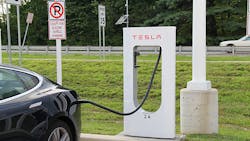Electric Vehicle Charging Opens New Avenues for Semiconductors
The charging infrastructure for electric vehicles is expanding throughout the United States, buffered by large investments from the automotive industry, government initiatives, and international calls to reduce carbon emissions. As a result, the market for semiconductors used in these charging stations is expected to grow rapidly over the next few years, according to a new report from chip industry research firm IHS Technology.
The revenues earned from the semiconductors built into charging stations was around $44 million in 2014, according to IHS Technology. However, the new report predicts that as more electric vehicles hit the road and the demand grows for additional charging stations, the global market for these components will reach approximately $233 million in 2019.
The bill of semiconductors used in charging stations is vast, ranging from the power semiconductors that channel electricity between the charger and the vehicle, to the communication chips linking the station to the smart grid. The report adds that the electric vehicle companies are trending toward systems-on-chip (SoCs) that not only provide faster control, but also include the memory chips required for secure communications.
In the United States, the infrastructure surrounding electric vehicles is still extremely limited relative to the nearly 253 million vehicles that were on the road in 2014, only a tiny fraction of which were electric. According to the Alternate Fuels Data Center, the Department of Energy’s clearinghouse for information on electric vehicles, there are now 11,578 electric charging stations and 29,436 public charging outlets spread across the United States, excluding private charging stations.
Noman Akhtar, an industrial semiconductors analyst for IHS, says that fast charging is a necessary step toward the widespread usage of electric vehicles and building out the infrastructure around them. And higher power ratings are required to support shorter charging times. “Electric vehicle charging stations with higher ratings require more power semiconductors, especially discrete semiconductor components,” he says.
Charging equipment for electric vehicles is classified by the rate at which the batteries are charged. AC Level 1 chargers, which are normally compatible with household outlets, add about 2 to 5 miles of range to an electric vehicle per hour of charging time, according to the Alternate Fuels Data Center. Although they requires special charging equipment, AC Level 2 chargers add about 10 to 20 miles of range per hour of charging time.
On the other hand, direct-current (DC) fast chargers represent the core technology within the public charging infrastructure, adding 50 to 70 miles of range in about 20 minutes, according to the Alternate Fuels Data Center. These stations are used by Nissan, Mitsubishi, and Tesla Motors in several different configurations and charging speeds. Tesla Superchargers can apparently provide 170 miles of range in about a half hour, delivering up to 120 kW of DC power directly to the battery.
In 2014, according to the IHS report, the average price for semiconductor components in a level-two charging station was about $143. By comparison, semiconductor components used in the latest fast-charging DC chargers now cost more than $1,000. DC chargers are almost universally favored in public infrastructure because they provide faster charge times, but it has become increasingly common for hotels and parking garages to invest in lower-cost AC chargers for vehicles parked in the same place for hours.
On another front, semiconductors are also required for the communications modules within the charging stations. In addition to smart grid compatibility, charging stations will eventually gain features like credit card readers, billing software, high-resolution displays, automated diagnostics, controlled power flow, and internal metering—all of which will require processors and other semiconductor components.
The IHS Technology report came as the climate change summit in Paris ended earlier this month, punctuated by an international accord reached by 195 countries to lower greenhouse gas emissions and mitigate the effects of climate change. According to a 2013 study by the Environmental Protection Agency, about 27% of the United States’ greenhouse gas emissions come from the transportation industry, only slightly less than the emissions from generating electricity.
About the Author
James Morra
Senior Editor
James Morra is the senior editor for Electronic Design, covering the semiconductor industry and new technology trends, with a focus on power electronics and power management. He also reports on the business behind electrical engineering, including the electronics supply chain. He joined Electronic Design in 2015 and is based in Chicago, Illinois.


